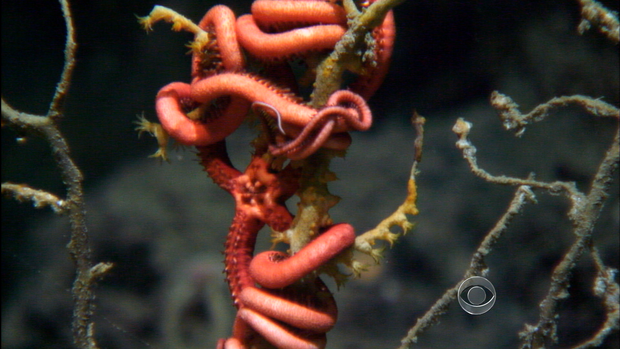Tar patches, deformed fish: Gulf shows signs of damage two years after oil spill
(CBS News) Two years ago tonight, the Deepwater Horizon drilling rig blew up off the Louisiana coast. Eleven workers were killed, and it caused the largest accidental oil spill in history: 200 million gallons of crude oil gushed from BP's well before it was capped nearly three months later.
Curious about the spill's effects, CBS News correspondent Elaine Quijano traveled to Port Sulphur, La. to look into it.
Quijano met Troy Frady, who runs a charter fishing boat off the Alabama Gulf Coast. Since the oil spill, he's been worried about some of the red snapper he's catching.
"One to two percent of the fish had these huge lesions on them and fin rot," Frady explained to CBS News. "We've never seen that before."
Gulf residents to get extra $64M for BP spill claims
AP photographer describes Gulf oil spill then, now
COMPLETE COVERAGE: Gulf Coast oil disaster
Researchers at the University of Florida are trying to determine what's causing the problem.
"You can't spill that much oil into the system without having long term negative consequences," David Muth, who is with the advocacy group National Wildlife Federation, told CBS News.
Muth took CBS News to an island, where weeks after the spill the pelicans were covered with oil. Muth says the oil is suffocating mangroves holding the soil in place.
Before the spill, one island CBS News visited was four acres in size. Now, Muth says it's less than an acre, a 75 percent loss of the island since the spill. In another two years, he thinks the island will be "completely gone."
Two years later, the oil is still present in some parts of the marshlands. You can actually see it in places, like tar patches and in other areas. The ground is so saturated you can actually see the oil bubbling up from the ground.
Penn State scientists say that dead coral now contains the chemical fingerprint of the BP Oil. The coral is covered in red, which are starfish.
Dolphins also show signs of distress. Last year in Louisiana, federal researchers say 179 dolphins were found stranded, nearly eight times the average. It's not clear whether the oil played a role.
BP has spent $14 billion on environmental cleanup. In a statement the company told told CBS News, "There is still work to be done and any and all conclusions about the health of the Gulf should be based on responsible science."
The Food and Drug Administration says it has extensively tested Gulf seafood, and it's safe to eat. But, Frady believes the gulf is still struggling.
"It's going to take many years of restoration in the Gulf to make it healthy," the fisherman said.
BP says it's committed to the largest and most complex study of the Gulf ever done. It's a study with high stakes for all involved.


